
Engine Modifications (Tuning)
The Triumph GT6 engine is very tunable, racing GT6s can put out in excess of 250bhp at 7500rpm (Kas Kastner). Back in the day, if you had a Triumph, and wanted extra performance from it, SAH were the people to go to. Founded by Syd. A. Hurrell who started by racing the Saab 93 and Lotus Elite in the late 1950s, followed by the Triumph TR3. In the early 1960s, realising there was a market for go-faster bits for the Triumph TR3 he set up S.A.H. Accessories Ltd of Leighton Buzzard in Bedfordshire. The rest, as they say, is history. Today SAH is part of Moss Europe, and it continues to sell go-faster parts for classic Triumphs, under the name of 'Triumphtune'.

There are a lot of opinions as how best to tune the Triumph I6 engine, depending on who is giving the advice! Basically to increase power in any internal combustion engine it is necessary to modify it to accept more air and fuel, and this is done by both increasing the airflow into the engine (via the carburettor or other device), and out of the engine (via the exhaust). Also increasing the airflow may require some modifications to the cylinder head by fitting bigger valves, etc. Of course doing all this may make the engine more powerful, so it is important to make sure that this power is delivered reliably so any serious modifications will need the engine to be strengthened so it doesn't break! Similarly if the car is driven harder it would be sensible to upgrade the suspension and brakes.
What modifications are made depend on your requirements (e.g. fast road, rally,race, etc) and, of course, your pocket! Generally upgrading any one aspect of the engine will work best when the other parts are similarly upgraded (the 'Holistic' approach). For example a higher lift camshaft may potentially increase the flow of air and fuel into and out of the engine by opening the valves further, but this will be limited by keeping the standard carburation and exhaust. Similarly the potential benefits of fitting a tubular exhaust manifold may be lost if the carburation and cylinder head are still standard (although they do sound good!). The advantage of the Lucas injection fitted to the TR5/6 and 2.5PI was that it permitted the fitting of a higher lift camshaft while still keeping reasonable tractability at low revs.
According to Bill Piggott the unsung heroes of Triumph tuning were Kas Kastner with driver Bob Tullius (of Group 44 fame). Together they helped to put Triumph on the map in the United States (their principal market) with their success with TRs, Spitfires and GT6s.
1. Carburation
The standard Stromberg CD150s work very well with a standard engine but increasing the air/fuel mixture going into the engine will necessitate fitting either bigger carburettors (Stromberg CD175s or similar size SU HS6s) or fitting Petrol Injection. Some swear by triple CD150s or even motorcycle carburettors such as Amals. When Triumph were uprating their engines, back in the day, Webers were favoured (usually triple 40DCOEs) but these are very expensive (seen below on the 1966 GT6R).
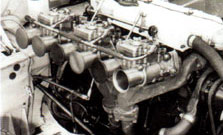
A new (11/2021) Weber GT6 3 x DCOE manifold & linkage set (see below) can be bought from WebCon of Sunbury for around £535 or £2262 including 3 x 40DCOE carburettors.
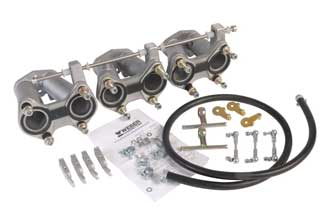
In its day, the Lucas Petrol Injection (PI) had a poor reputation which is why Triumph themselves ended by replacing it with carburettors. This was mainly due to two factors, fuel vapour locks in hot countries, and an unreliable high pressure fuel pump (allegedly based on the Lucas windscreen wiper motor!). These days these problems can easily be overcome by, for example, fitting a Bosch fuel pump. Fitting PI to a GT6 is not easy, due to bonnet clearance problems, but the Mk3 below has it, although the bonnet had to be modified!
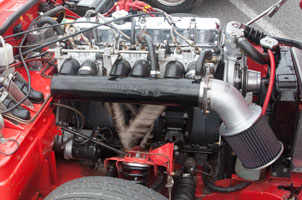
2. Cylinder Head

Early GT6s (Mk1) have a different cylinder head to the later ones which were fitted with the TR5 "full-width" head. This had a different casting from the original GT6 head and featured different inlet and exhaust ports (unlike the Mk2 head, above, all the ports are inline). The earlier head also has the pushrod tubes visible between the spark plugs, and slightly smaller studs. Of course earlier cars can be modified by fitting a later head. The late GT6 Mk3 head (and others) had smaller exhaust valves to discourage cracks which can appear between the valves and these are valued because there is more room to fit larger inlet valves. A cylinder head specialist with a particularly good reputation is Peter Burgess (www.mg-cars.org.uk/peterburgess) but of course there are others. The data below is from the Chris Witor webite and may not be accurate!
| Car | Head No. stamped | Casting No. raised | Height nominal (inches) | Piston type | Exhaust valve (mm) | Pushrod length (inches) | EGR hump | Rear water slot |
| GT6 Mk1 | 517528 | 308351 | 3.300 | Flat | 32 | 8 | No | Yes |
| GT6 Mk2 | 218225 | 312388 | 3.400 | Dome | 32 | 8.125 | Yes | No |
| GT6 Mk3 | 219015 | 313248 | 3.400 | Dome | 30.3 | 8.125 | Yes | No |
According to a Club Triumph forum, the late heads (219015 & 219016) have smaller exhaust valves, thicker castings and a lower compression ratio. These were possibly for 2000TC and S. According, again to Chris Witor, "We Advise This Smaller 30.3mm Valve Over The 32mm For All Normal Road/Fast Road Use. Heads That Had The 32mm Valve Can Be Inserted Down To Suit. 30.3 is Acclaimed To Be Good For Up To 200 BHP, Smaller Valves Run Cooler, Heads Are Less Likely To Crack, And There is Less Wasted Inlet Charge Entering The Exhaust Port During Overlap".
3. Exhaust Manifold and Silencers
The exhaust/silencer system includes the exhaust manifold and the silencer(s). The general consensus is that a tubular 6-3-1 manifold, allows the exhaust pulse of paired cylinders to resonate as negative waves back up the opposite primary to reinforce extraction, inproving performance over the cast iron version. Gareth Thomas claims to have the best design, and this has allegedly been 'stolen' by others. A popular tubular manifold is the Phoenix, example below (available from Rimmers for £592.80).

4. Camshaft
Classic & Sports Car’s Features Editor Greg MacLeman, who owns a 1974 Triumph 2500TC, which has a similar engine to the GT6, and he has taken it to 'Stage 2' (December 2019 issue) and this includes a re-profiled camshaft. He took it to Piper Cams who re-profiled it to 'yellow' specification - "a grind that majors on usable torque and came highly recommended by Matt George and Jason Wright at TRGB".
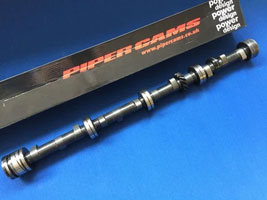
Common sense says that the best way to 'tune' an engine is to ensure that everything is as it should be! First, make sure that all the ignition components are in tip top condition and then ensure the ignition is timed correctly. Then adjust the carburettors to ensure the mixture is correct and also balancing them is beneficial. If you still want to modify your GT6 for more power, the books featured below may help!
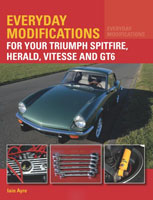
Iain Ayres book "Everyday Modifications for your Triumph Spitfire, Herald, Vitesse and GT6", above, gives a good overview and he refers to some of the more in-depth books below.
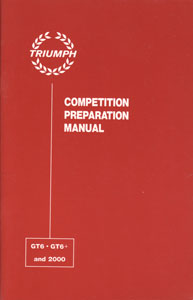
The 'Guru' of Triumph engine modification is Kas Kastner, who single-handedly launched Triumphs’ very successful Competition Department and literally wrote the book on tuning Triumphs for higher performance, the 'Triumph Preparation Handbook' (see above). You can visit his website by clicking here, where you can download an e-book (PDF) for $17.95. His advice is quite detailed and follows a lot of actual experience on the track and he was very successful so his opinions should be respected.
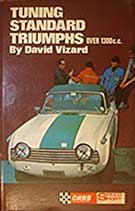
Another 'Guru' is David Vizard whose book "Tuning Standard Triumphs Over 1300cc" was published by Triumph themselves. Ex-aerospace engineer David Vizard is one of the world's most widely published automotive writers. He holds numerous patents and is a winning engine/car builder so should know what he is doing! You can download a PDF of the Standard-Triumph version by clicking here.

Gareth Thomas is a bit of a maverick when it comes to Triumph tuning. According to his website, many of his ideas have been stolen. According to Christian Marx on the Kas Kastner's Forum "The book is different to the Kas Kastner books. The Kastner books are on the practical side, hard facts combined with well tested tuning ideas that are needed for winning races. The Thomas tuning manual is more of theoretical nature. He gives a good view on how combustion and gas flow works. It's a good help to get an idea of the engineering side of engine development. I would think....the Thomas book is a very good enhancement of the Kastner books. I recommend it". You may be able to get a copy of his Tuning Manual from his website http://www.jagclub.ru/triumph_tun.html but be warned, they are like hen's teeth!
![]()